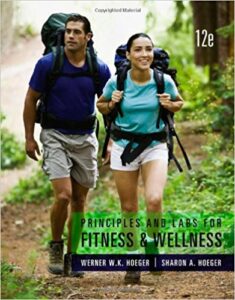Description
Test Bank For Principles and Labs for Fitness and Wellness 12th Edition By Hoeger
Chapter 8 – Muscular Flexibility
Chapter Learning Objectives
- Explain the importance of muscular flexibility to adequate fitness.
- Identify the factors that affect muscular flexibility.
- Explain the health-fitness benefits of stretching.
- Become familiar with a battery of tests to assess overall body flexibility (Modified Sit-and-Reach Test, Total Body Rotation Test, Shoulder Rotation Test).
- Be able to interpret flexibility test results according to health-fitness and physical-fitness standards.
- Learn the principles that govern the development of muscular flexibility.
- List some exercises that may cause injury.
- Become familiar with a program for preventing and rehabilitating low-back pain.
- Create your own personal flexibility profile.
True/False
LO# An. Question
1 F 1. Too much flexibility is a risk factor for falls and subsequent injury among older adults.
2 T 2. Flexibility is joint specific and varies from one individual to the next.
2 F 3. Flexibility is usually greater in those with more body fat.
2 F 4. Elastic elongation can occur in joint capsules, ligaments, and tendons.
4 T 5. The Modified Sit-and-Reach Test accounts for arm versus leg length differences.
4 T 6. Posture tests are best conducted in early life.
6 F 7. Controlled ballistic stretching is not recommended.
6 T 8. PNF stretching is thought to be more painful than other static techniques.
6 F 9. The intensity of a flexibility stretch should exceed the point of mild discomfort.
8 T 10. The most common reason for chronic low-back pain is a lack of physical activity.
Multiple Choice
LO# An. Question
1 b 11. The range of motion at a joint or group of joints that can be achieved without causing injury is known as:
- stretching.
- flexibility.
- elongation.
- elasticity.
1 b 12. When joints are regularly moved through their entire range of motion:
- flexibility decreases.
- flexibility increases.
- muscles shorten.
- ligaments shorten.
1 a 13. Running regularly without proper stretching:
- causes muscles to tighten.
- increases muscular flexibility.
- causes plastic elongation.
- causes elastic elongation.
1 a 14. Poor posture and subsequent aches and pains that lead to limited and painful joint movement can be caused by:
- a decline in flexibility.
- an increase in coordination.
- lack of adipose tissues.
- too-strong muscles.
1 d 15. Approximately _____ percent of all low-back problems in the United States stem from improper alignment of the vertebral column and pelvic girdle, a direct result of inflexible and weak muscles.
- 20
- 40
- 60
- 80
2 d 16. Which of the following affects flexibility?
- bone structure
- muscle structure
- overall height
- genetic factors
2 b 17. Permanent lengthening of soft tissue is called:
- elastic elongation.
- plastic elongation.
- plastic flexibility.
- plastic stretching.
2 a 18. Temporary lengthening of soft tissue is called:
- elastic elongation.
- plastic elongation.
- plastic flexibility.
- plastic stretching.
2 d 19. Changes in muscle temperature can _____ flexibility.
- only increase
- only decrease
- neither increase nor decrease
- increase or decrease
2 b 20. The most significant contributor(s) to lower flexibility is (are):
- age and sex.
- sedentary living.
- muscle temperature.
- excess adipose tissue.
3 b 21. Good flexibility has been shown to:
- induce low-back pain.
- improve personal appearance.
- increase muscle soreness.
- improve body composition.
3 c 22. Stretching routines have been found to reduce:
- the risk of heart disease.
- blood glucose level.
- psychological stress.
- blood LDL cholesterol.
3 c 23. Stretching exercises are helpful for:
- improving muscular endurance.
- increasing muscular strength.
- maintaining body mobility.
- enhancing body composition.
3 b 24. Decreased flexibility causes older adults to:
- have a higher level of functional capacity.
- lose mobility for simple daily tasks.
- switch lanes and parallel-park better.
- have a reduced risk for automobile accidents.
3 b 25. Flexibility exercises have been prescribed successfully to treat all of the following EXCEPT:
- stress.
- subluxation.
- knots in muscles.
- dysmenorrhea.
3 c 26. Taking part in a regular stretching program offers all of the following benefits EXCEPT that it:
- promotes proper and graceful body movement.
- prevents low-back and other spinal column problems.
- increases muscular strength and endurance.
- improves and maintains good postural alignment.
4 d 27. The Modified Sit-and-Reach Test:
- modifies the test results for those with longer arms as compared to legs.
- underestimates flexibility for those with longer arms as compared to legs.
- underestimates flexibility for those with shorter legs as compared to arms.
- considers arm and leg lengths in determining the flexibility measurement.
4 c 28. Which of the following tests measures the flexibility of the hamstring muscle and, to a lesser extent, the lower back muscles?
- Total Body Rotation
- Shoulder Rotation
- Sit-and-Reach
- Repetition Maximum
4 a 29. All other factors being equal, an individual with longer arms or shorter legs, or both, receives a better rating from the _____ Test.
- original Sit-and-Reach
- Modified Sit-and-Reach
- Total Body Rotation
- Shoulder Rotation
4 c 30. The reason that the Front-to-Rear Splits Test and the Bridge-Up Test are not included to determine one’s flexibility profile is that:
- they do not consider an individual with long arms and/or shorter legs, or both.
- everyday movements, such as reaching, bending, and turning, are not important.
- they do not represent actions that most people encounter in their daily life.
- they only measure the hamstring muscles and the lower back muscles.

Reviews
There are no reviews yet.